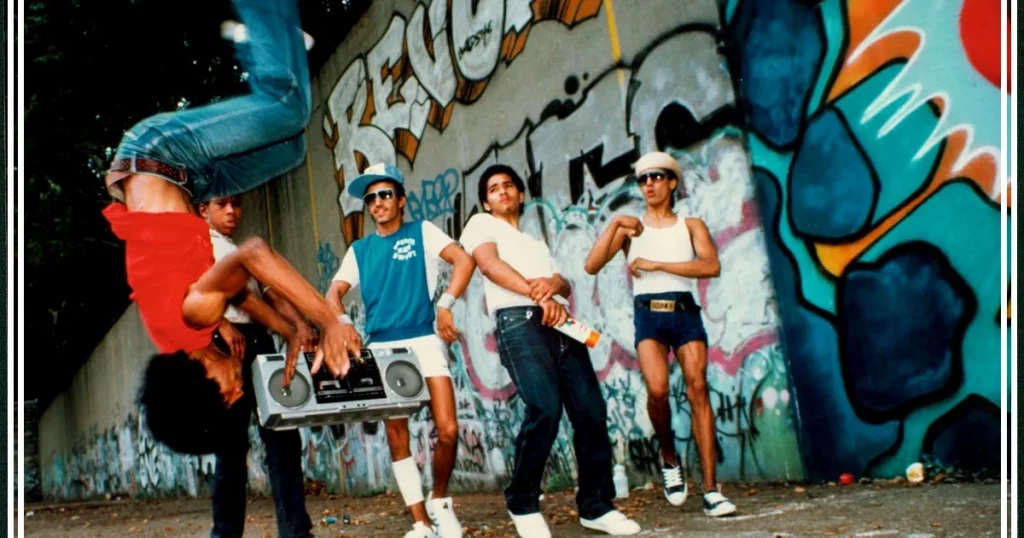Well into its forties, Hip Hop has grown into a forever evolving and successful force in popular culture. Now with children of its own and plenty of adult issues to handle, Charlie Ahearn’s cult classic Wild Style (1982) is the home video to remind it of simpler, more innocent times. The first film to document Hip Hop in its infancy and beyond, Wild Style is the text book for Hip Hop 101 and a must see for all seeking knowledge on Hip Hop and its foundation.
Filmed in the poverty stricken backdrop of the South Bronx, NYC in the early eighties, the docudrama followed many of Hip Hop’s key figures. Legendary graffiti artist Lee Quinones played the main character, Raymond aka “Zoro,” one of the most elusive graf artists in the South Bronx. Zoro, a passionate artist, was learning to adapt to his unique “wild style” of art becoming less underground and was unsure if graffiti was being compromised by leaving its risky, illegal roots of the train yard and streets for the mainstream. In turn, this caused problems with his girlfriend Rose aka “Lady Bug” (played by the queen of graffiti Sandra “Lady Pink” Farara), who was seeking others forms of expression and started hanging with another crew of graf artists, The Union Crew.
Learning that The Union Crew was making money from doing murals, Zoro sought out the advice from his friend Phade, who was played by the film’s co-producer, music director, graffiti artist and Hip Hop legend, Fab 5 Freddy. Ever a hustler, Phade introduced Zoro to Virgina, a news reporter played by legendary underground film actress Patti Astor, who was doing a story on the graffiti, rap and breaking scene. Virginia introduced Zoro to some of her rich friends who commissioned him to do some artwork on canvas. Learning to grow with his art, Zoro agreed to help Phade by doing a mural on an amphitheater where a rap jam would be held. After debating what to paint for the mural, Zoro decided to construct a picture of his alter ego but couldn’t seem to make it work. He talked it over with Rose, who made him realize the concept was selfish and the mural should have been about the rappers and breakers performing at the jam and not him. Finally understanding how his art fit into the world he loved, Zoro painted a mural that set the scene for the jam that showcased the four core elements of Hip Hop.
Outside of telling the story of Zoro, Wild Style also featured many real artists responsible for building the foundation of Hip Hop as we know it. Fab 5 Freddy’s character “Phade” managed a club in the South Bronx and early in the film, the audience was treated to an ill rap battle between The Chief Rocker Busy Bee & D.J. AJ versus Rodney “C” of Double Trouble. The battle took place in a hole in the wall club that was mostly dark except for the light over the turntables, which was manned by the inventor of scratching, D.J. Grand Wizard Theodore.
The breakers featured in the film were the Pop-o-matics, Electric Force and the world renowned Rock Steady Crew. Ahearn also put together a musical number that featured two of the most street level MC group rivals: The Fantastic 5 Romantics (or Freaks) and The Cold Crush Brothers. Much like the fight scene in West Side Story, the two groups faced off on a basketball court while rapping about how they would destroy their opponent lyrically and on the court. Their performances carried over into another club scene, where Kevie Kev, Master Rob, Rubie Dee, Prince Whipper Whip and Dot-A-Rock of the Fantasic 5 traded rhymes with D.J. Charlie Chase, D.J. Toney Tone, Grandmaster Caz, Jerry Lee Lewis, Almighty KG and Easy AD of Cold Crush. All of these performers, including KK Rockwell and D.J. Stevie Steve (the rest of Double Trouble) performed at the jam, which showed more like a real party than a film set.
Outside of Chic’s “Good Times,” which was spun by D.J. D.ST at the end of the jam, Fab 5 Freddy and other musicians he knew, including some of the members of the band Blondie, of “Rapture” fame, created all the music for the film. In one scene, D.J. Grand Master Flash, the inventor of cutting, rocked the turntables to some of these original instrumentals. In addition, the soundtrack was held down by the theme song, which featured Grandmaster Caz rapping about how he viewed the South Bronx. The music in the film can still be heard today, most notably on the track, “Genesis” on Nas’ Illmatic, which took a sound clip of a conversation between Zoro and his brother, as well as the music from the theme song.
The technical aspects of the film were very low-tech considering the small budget for the film but Ahearn made it work. The use of panoramic views of the train yards and the deserted streets of the South Bronx gave the audience a real sense of the conditions graf artist were attempting to beautify with their art. Iconic graf artists Dondi, Crash, Daze, Caz, Obe and Zephyr (who played “Z-Rock”) added their work to the film, along with Lee Quinones and Lady Pink.
It goes without saying that Wildstyle is the most important film in Hip Hop’s history. Outside of it being the first Hip Hop motion picture, it also captured the true essence of all of the elements and showed how they came together to form the culture that would take over America. This film set the tone for all Hip Hop themed films to come and is the perfect tool for teaching those unfamiliar with the roots and true origins of Hip Hop.



